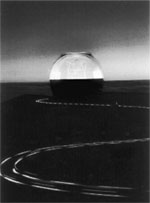Constant changes
 light from far-flung quasars (celestial objects optically resembling a star but extremely remote and immensely powerful sources of light and other radiation) may change the way physicists see the Universe. An international team of scientists says it may have found evidence from these distant beacons that a constant that determines the strength of an electromagnetic force may have been different earlier in the Universe. "It would certainly be a major development, making obsolete much of what we now know about the Universe," says astronomer Mike Hawkins of the Royal Observatory in Edinburgh, uk (New Scientist, Vol 157, No 2127).
light from far-flung quasars (celestial objects optically resembling a star but extremely remote and immensely powerful sources of light and other radiation) may change the way physicists see the Universe. An international team of scientists says it may have found evidence from these distant beacons that a constant that determines the strength of an electromagnetic force may have been different earlier in the Universe. "It would certainly be a major development, making obsolete much of what we now know about the Universe," says astronomer Mike Hawkins of the Royal Observatory in Edinburgh, uk (New Scientist, Vol 157, No 2127).
The constant in question is known as the fine structure constant, which depends on three other quantities: the charge on the electron, Planck's constant (one of the fundamental physical constants relating energy of a quantum of electromagnetic radiation to its frequency) and the speed of light. "If our results are correct, one or more of these constants must have varied over the history of the Universe," says Christopher Churchill of Pennsylvania State University, usa.
Working with Churchill and John Barrow at Sussex University, uk , John Webb and team at the University of New South Wales in Sydney, Australia, used a new technique to measure the fine structure constant at various epochs of the Universe. They looked at the "bites" taken out of quasar spectra by light-absorbing atoms in gas clouds between the quasars and the Earth.
The difference between the wavelengths absorbed by any two elements is sensitive to the value of the fine structure constant at the time of absorption in each cloud. The team measured wavelength differences to within ten-thousandth of a nanometre at the 10-metre Keck telescope in Hawaii.
The results showed that the fine structure constant was several parts in 100,000 smaller than today between a red shift of 1.0 and 1.4. Red shift is a measure of how much the Universe has expanded since the clouds emitted light, and is also a rough guide to their age.
If the variation is real, the implications will be profound. Many theories attempting to unify gravity with the other forces require extra dimensions of space-time. We do not experience them as they are "rolled up" smaller than an atom. In such theories, the constant that determines the strength of the electromagnetic force depends on how tightly the extra dimensions are rolled up. "If the fine structure constant has changed with time, it could be the evidence that the size of the rolled-up dimensions has changed," says Churchill.
In the past, several scientists, among them British physicist Paul Dirac, have speculated that fundamental constants of physics evolve with time. According to Churchill, such changes might be connected with changes in the energy density of the vacuum. For instance, he points out, the speed of light depends on the interaction between photons and the quantum vacuum, which seethes with "virtual" particles popping in and out of existence. "If the energy density of the vacuum were greater in the past, the speed of light, too, would be slightly different," he says. Differences in the fine structure constant could also have affected element-building nuclear reactions in stars, which are extremely sensitive to such physical constants. "A change in this constant could change the rate at which the stars burn their fuel and so subtly alter the entire evolution of stars," Churchill points out.
"It's hard to imagine the full ramifications of changes to fine structure constant," comments Hawkins. Depending on how the constant changed with time, he says it might make some atoms unstable during certain epochs. "If the variation is true, it is extremely significant," adds Tom Kibble, a theoretical physicist at Imperial College, London, uk. "But I would certainly want to look for other possible explanations of the data before accepting this one." Churchill admits the results could be a mirage due small calibration errors: "We're currently working very hard to rule this out."
Related Content
- The cost of climate change on households and families in the EU
- Compliance report by Arunachal Pradesh on measures to offset the adverse impact of tourism activities on the environment, 10/10/2023
- SDG pulse 2022
- Mainstreaming food security and nutrition in emergency preparedness and response: capacity and needs assessment report
- Environment (Protection) Third Amendment Rules, 2022
- Identifying the poor: accounting for household economies of scale in global poverty estimates
